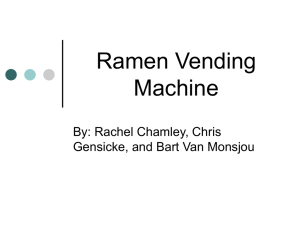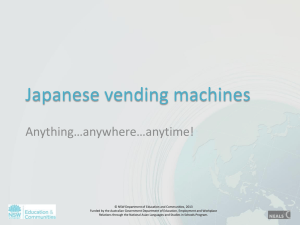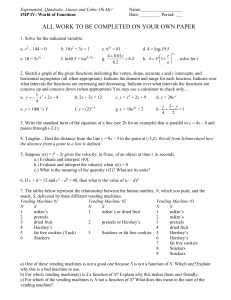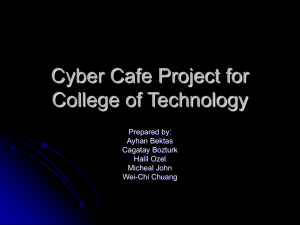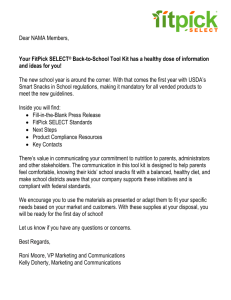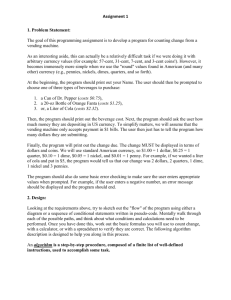About the Vending Industry
advertisement
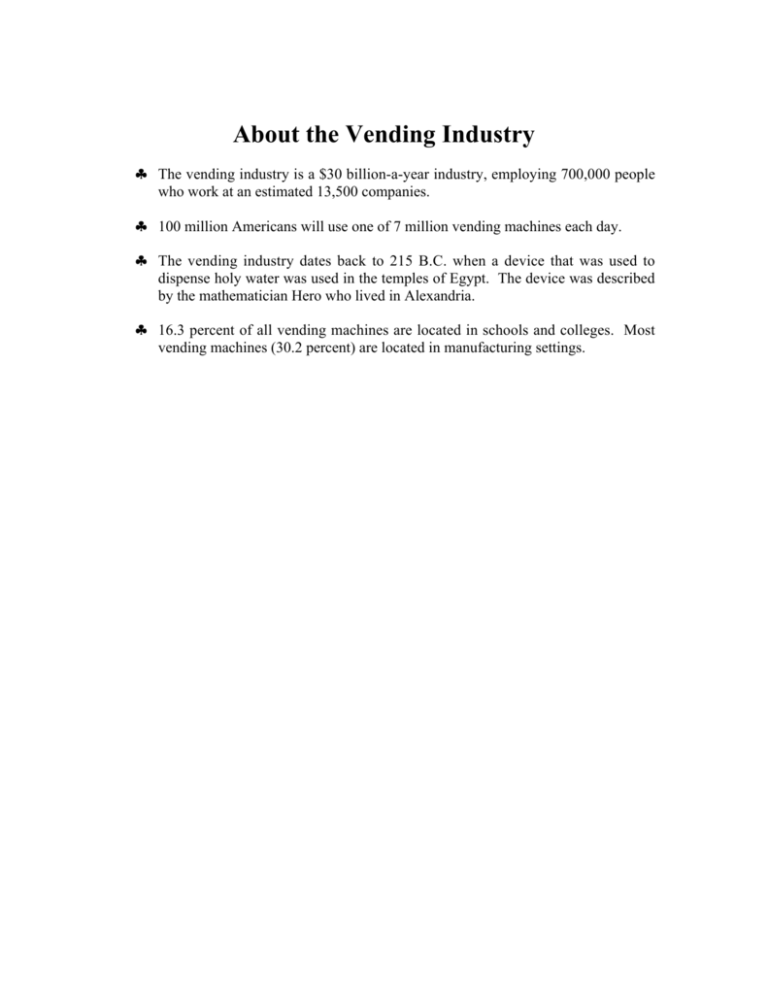
About the Vending Industry ♣ The vending industry is a $30 billion-a-year industry, employing 700,000 people who work at an estimated 13,500 companies. ♣ 100 million Americans will use one of 7 million vending machines each day. ♣ The vending industry dates back to 215 B.C. when a device that was used to dispense holy water was used in the temples of Egypt. The device was described by the mathematician Hero who lived in Alexandria. ♣ 16.3 percent of all vending machines are located in schools and colleges. Most vending machines (30.2 percent) are located in manufacturing settings. Industry Backgrounder: Vending and the Technological Revolution Delivery Systems of the Future The Fresh Food Choice for People on the Go! Ask most people to define the vending industry and they’re likely to mention soda, chips and candy. But while these products are still a staple in the industry, the truth is that a revolution in technology has transformed vending into a $30 billion industry specializing in convenience and fresh products. Today consumers can use vending machines to help them streamline their busy lifestyles by purchasing everything from cameras and vitamins to pasta dinners and lobster bisque. Advances in technology and the growth of the internet have created unlimited potential for this ultimate self-service vehicle, while more services, various payment options, and easier usage have made shopping through a vending machine easier, quicker and more reliable than ever for consumers. The truth is that nowadays you can get just about anything you can think of from a vending machine. In addition to the standard tradition vending snacks, you can also buy audio books and fresh flowers, or pick up some eggs or a gallon of milk on the way home. At Shop 2000 in Pennsylvania, consumers can use a credit card and choose on a touch screen among 200 items ranging from brake fluid to a gallon of milk. A basket on a conveyor belt stops at the items selected, then the machine drops each selection into the basket which falls down the opening in the machine. Best of all, today’s new machines and all their technological advances mean consumers have access to the freshest products possible 24 hours a day, seven days a week. Frozen foods can stay fresh longer, vending machine menus can be posted on web sites and ordering and financial transactions can be managed via the web as well. Truly today there is no limit to what can be purchased via vending machines. An Age-Old Industry While today’s technologically enhanced machines may be new, there’s nothing new about vended products. In fact, as far back as 215 B.C., the mathematician Hero described a device that dispensed Holy Water used in the temples of Egypt. Here in the U.S., Thomas Adams installed Tutti-Fruiti gum machines in 1888, on New York elevated train platforms, and forever rewrote the way Americans purchase products. The industry continued to expand in 1902, when the novel Automat restaurant was opened in Philadelphia, and even more so in 1905, when the U.S. Post Office began to use stamp vendors. Later, bottled soft drinks cooled with ice started appearing in the marketplace, and in 1946, the first coffee venders led to the use of vending machines for coffee breaks. In 1963, vending companies added to their refrigerated sandwich machines by furnishing microwave ovens to heat refrigerated food, and in 1978, the first water vending machines were introduced. By 1985, many machines were fitted with credit and debit cards for payment services, and in the 1990s, machines specializing in freshly brewed flavored coffees, espresso, and cappuccino entered the marketplace. For the new century, many of today’s machines even offer access to the internet. Ultimate Self Service As the technological revolution continues to unfold, vending will offer new opportunities for consumers to streamline their busy lives. Imagine, for example, instead of waiting in a long line to check into your hotel, swiping a card into a machine. Out comes a magnetic striped key to a hotel room. Use the same card later in the hotel’s vending machine to purchase a freshly made pizza where the charges are instantly billed to the credit card used to secure the room. Tired of waiting in line at Blockbusters? Use your credit card and rent your movie from a vending machine. And why not get some books, music and toys for your kids from a vending machine while you’re at it? Such advances are in our very near future and will become more and more prevalent as manufacturers continue to adapt emerging technologies to the vending industry. Although many predictions for the industry’s future may seem far-fetched, in many other countries vending is already an integral part of day-to-day shopping. In Japan, for example, consumers spend approximately $56 billion at more than 5.5 million machines, or one machine for every 20 people. Although Japanese consumers can already purchase just about everything from vending machines, now they can shop at Tokyo’s first fully automated convenience store where shelves are filled with everything from gum, batteries and noodles to dried squid, hair tonic and green tea. The machine offers 200 different products at three different temperatures thanks to its advanced mechanical engineering. Another Japanese company, Fujitaka, has created a machine that looks like a department store window and can sell everything from books to clothing. When and Where You Want It From the Holy-Water machines of Hero’s day to today’s machines connected to the internet, the basic objective of vending remains the same: to provide a fresh, quality product, 24 hours a day, seven days a week, helping consumers better manage their busy lifestyles. NAMA is the national trade association of the food and refreshment vending, coffee services and on-site foodservice management industries. Its membership is comprised of service companies, equipment manufacturers and suppliers of products and services to operating service companies. The basic mission of the association, to collectively advance and promote the automatic merchandising and OCS industries, still guides NAMA today as it did in 1936, the year of the organization’s founding. The organization relies solely on membership dues, Expo revenues and the generous donation of its sponsors. Vending in the US: NAMA Pushes the Industry Forward Almost 120 years ago, vending officially burst on to the American landscape when Thomas Adams made the fateful decision to install Tuitti-Fruiti gum machines on New York’s elevated train platforms, forever rewriting the way Americans purchase products. Today in the United States you can purchase everything from books and CDs to office supplies and laundry detergent from a vending machine. The evolution of the industry, transformed by both technology and the growing demands fueled by consumers looking to streamline their busy lives has been driven by the industry’s trade association, the National Automatic Merchandising Association (NAMA) which has been working to push the industry forward since its inception in 1936. NAMA represents service companies, equipment manufacturers and suppliers of products and services to operating service companies in the food and refreshment vending, coffee services and foodservice management industries including on-site, commissary, catering, and mobile. The organization’s mission is simple: to collectively advance and promote the automatic merchandising and coffee service industries. From developing programs to help enhance the image of our industry and creating education and certification programs, to reaching out internationally to collaborate with our overseas partners, NAMA is working on the forefront of a wide array of critical issues facing the future of our industry and working to ensure our members flourish. When NAMA was first created, the industry was still expanding in the US with what was then the novel Automat restaurant in Philadelphia, Pennsylvania, and the U.S. Post Office beginning to use vending machines to issue stamps. Later, as technology improved, bottled soft drinks cooled with ice started appearing in the marketplace, and in 1946, the first coffee venders led to the use of vending machines for coffee breaks. In 1963, vending companies added to their refrigerated sandwich machines by furnishing microwave ovens to heat refrigerated food, and in 1978, the first water vending machines were introduced. By 1985, many machines were fitted with credit and debit cards for payment services, and in the 1990s, machines specializing in freshly brewed flavored coffees, espresso, and cappuccino entered the marketplace. By the turn of the new century, vending stepped on to the world-wide web as machines connected to the internet ushered in a sweeping array of next generation technology, creating unprecedented industry advances. All along the way NAMA helped create the resources to help companies succeed and push the industry forward. For example, NAMA has designed countless programs, services and educational resources designed specifically to help members succeed in each aspect of the industry. In government affairs, NAMA protects members from harmful legislation – things like stopping new tax laws, keeping existing tax laws in check or halting efforts to redesign the dollar bill. In the education department, NAMA created dozens of cutting-edge programs offered all across the country throughout the year to help members better understand technology; learn important management insights; or learn how to tap into the gourmet coffee market by learning to brew the certifiably best coffee possible. NAMA’s Communications Department recently released a video, “The Fresh Food Choice for People on the Go,” designed to change outdated misperceptions about the industry and better help tell the true story about vending and coffee service. Just some of the other programs and resources NAMA has created to help members succeed and push our industry forward include: Business and Ethical Standards. NAMA created a Code of Business and Ethical Standards designed to create and promote the highest principles of quality service, community relations, safe environment, respect and honesty, integrity and responsibility in the ethical conduct of business. Signing the Code is a condition of membership. National Certified Executive (NCE) Program – NAMA created this certification program to showcase the best and brightest executives in the industry by recognizing their accomplishment, initiative and professionalism. The NCE designation tells the world about the individual’s commitment to excellence and dedicated service to the industry. Trade Shows – NAMA creates unmatched networking and buying opportunities at the world’s largest shows specifically serving the vending, coffee service and onsite food services industry. Nowhere else in the world can you find a better opportunity to meet colleagues, close deals and learn more about the industry than at NAMA’s two Expos. The Spring Expo will be held April 7-8, 2005, with educational sessions April 69 in Las Vegas, and the next National Expo will be held October 27-29, 2005, in Atlanta, GA. Legislative and State Council Support – NAMA represents the industry’s concerns in state capitals coast-to-coast, fighting tax increases and other harmful legislation, while advancing issues of concern to us all. When legislatures are considering new laws or regulations, together with the state councils, NAMA works to ensure the industry’s voice is heard and interests are protected. Office Coffee Service - NAMA provides members with up-to-date information on a wide variety of coffee service topics prepared by dedicated coffee services staff personnel and the NAMA OCS Committee. Coffee Service industry specific operations manuals, publications and training and development programs are all available to help NAMA members succeed. Education – NAMA is the only organization providing educational resources created specifically to help members of the industry solve problems and succeed. From numerous Expo education sessions to the highly acclaimed Coffee Certification program where program attendees learn to brew the certifiably best coffee possible, NAMA is the leader in guiding the future of health, safety and technology of our industry. Michigan State University Executive Development Program – Thanks to this program created in conjunction with one of the nation’s oldest and most prestigious hospitality based business schools, industry leaders can attend an intensive week-long educational session where they can learn graduate-level strategic thinking skills and business advice from some of the world’s most respected professors. Essentially the program is an intense exposure to the skills, thinking processes, and textbook work that make up a Masters of Business Administration degree. Health, Safety & Technology - NAMA develops a wide variety of publications for members on topics ranging from maintenance training and microwave oven safety to public health regulations. NAMA also works with machine manufacturers and software firms to establish technology standards. Food Service Management – NAMA offers resources specifically to help executives in food service management. United States vending operators conduct more than $10 billion in on-site foodservice transactions and 44 percent of vending operators run on-site foodservice operations. Vending in the United States has come a long way since the days of the TuttiFrutti gum machines. Today for millions of busy consumers each day, new machines and all their technological advances mean access to the freshest products possible 24 hours a day, seven days a week. Thanks to vending, it’s there when and where you want it. RICHARD M. GEERDES President & Chief Executive Officer National Automatic Merchandising Association 20 North Wacker Drive, Suite 3500 Chicago, IL 60606 (312) 346-0370 (312) 704-4140 Fax Rich Geerdes assumed the leadership of NAMA January 1, 1999. A native of Chicago, Rich holds an MBA in Finance and a Bachelors Degree in Management and Information Sciences from Western Illinois University. His education was completed in 1975 after several years of service in the U.S. Army, domestically and in Viet Nam. Rich has worked at NAMA since 1988. He has had responsibility for Membership, Conventions, Education, Strategic Planning, Communications & Public Relations, Accounting, MIS and other areas as well. Rich joined the staff of NAMA following his experience as an operator in a series of senior management positions with Interstate United and Canteen Corporation. He also serves as the President of The Foundation of NAMA. Rich has been active in leadership roles with several business, school and community organizations, including the Civil Air Patrol, President of Sigma Iota Epsilon National Business Honor Society, Board Member & Officer of his church school Athletic Association, Chairman of the Planning Committee for his church Management Council, and Vice Chairman of the Marketing Committee for a local high school Board of Advisors. He received the 2002 Honorary Alumni of the Year award for The Hospitality School of Business at Michigan State University. He is proud to be a NAMA Certified Executive (NCE). Rich has been a rated pilot, a certified tower and radar approach control Air Traffic Controller, has taught Finance at the University level, coached grade school basketball and in his spare time plays golf. He and his wife Joan have two grown sons and they live in Hickory Hills, IL, southwest of Chicago. ♣
